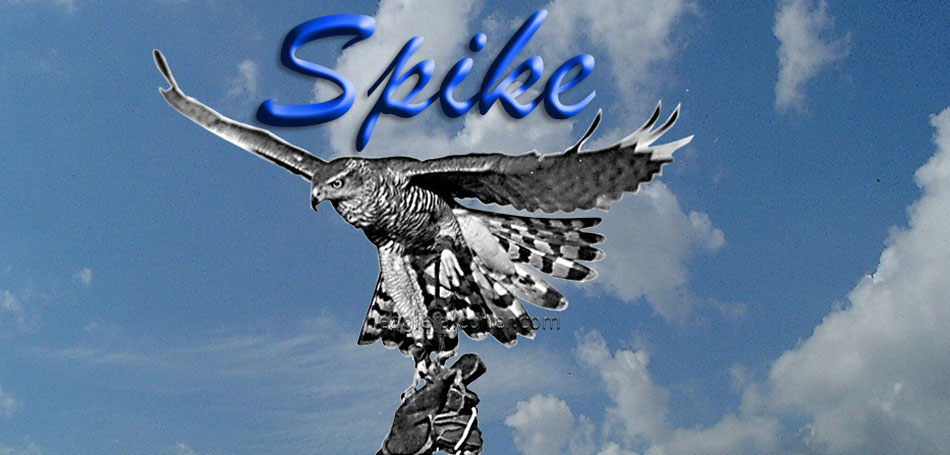'Spike'.
by
Alan Gates.
First Published in the Austringer 1989. 
I have always had an ability to daydream, not the sort where the dreamer is in a sort of motionless trance. No, mine is an ability of vivid recollection of past moments whilst still carrying out my daily tasks.
Spike was a male eyas German goshawk, I say was, because he has sadly long gone to the happy hunting grounds in the sky. He was such an outstanding little character and dedicated hunter that he often occupies those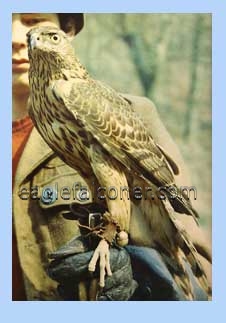 precious moments of my daydreams. precious moments of my daydreams.
Like all of the best things in life he came straight out of the blue. At the time I was living on my native island of Jersey in the Channel Islands, and working for an electronics firm on a very agreeable evening shift of 4 p.m. until 12 midnight. This was an excellent way to do a days work for a young falconer, as in the winter months I was able to fly my hawks every day, weather permitting.
One warm evening in August 1968 I received a telephone call from Mike Dawson in Brighton. Mike was then secretary of the Hawking Club of Great Britain of which I was a member. “Do you want a goshawk” were the words that greeted me as I picked up the receiver. “Well I’m not sure really” I said, I was a bit taken aback, as I had not been looking for a new hawk. “Why, whose gos is it anyway ?” I said. “I’ve got this young German student staying and he has brought an eyas male gos over for some pocket money”, explained Mike. “How big is he and how much does he want for him?” I asked. “Small and cheeky like me, and he wants twenty quid” came back the reply. “What, twenty quid! I can’t afford that”, I said. “O.K. I’ll tell him you only have fifteen if you want him,” said Mike. “Oh go on then “, I heard myself say. “Good, we’ll send him over tomorrow, see ya!, Click brrrrr, he was gone. Two minutes that’s all it took. Certainly the quickest goshawk I ever obtained.
The next day just after lunch I received a telephone call from a customs officer at the airport. “Afternoon sir, I have a box with a great big hawk in it, will you come and collect it?” said the voice on the phone. “Great, I’ll be there in half an hour”’ I said.
Within the hour I was back home and in a darkened shed with my new gos standing on my fist. In the dimmed light, I could see he was much redder in colour than the passage hawks I was use to.
Mike was right, he was small, if he weighed one and a half pounds he was lucky. I was a little disappointed about the size. He also had about an inch missing from the ends of his two deck feathers. Mind you, he was steady, and was soon feed on the fist. I took his training very steady. As it was still quite hot in the midday sun. First thing in the mornings he was walked on the fist and then flown a short distance on a creance and fed up on the fist. He spent the afternoons in the shade on his bow perch and at night in a shed.
I had received an invitation as a member of the H.C.G.B. and WH,C. to partake in the second International 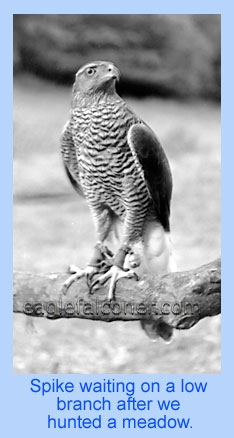 Hawking Meeting of the Austrian Falconers Club, the O.F.O. It was to be held in Lower Austria near a small town called Markegg. The accompanying details of the forthcoming week's meeting sounded very good. I was keen to go, but did not have the funds. A few weeks later the Managing Director of the Company I worked for, was enquiring as to the welfare of my hawks and I happened to mention the Austrian meeting. To my surprise he replied that he was sure that there was some equipment in our division in Vienna that needed some repair work and he would arrange for me to visit. Hawking Meeting of the Austrian Falconers Club, the O.F.O. It was to be held in Lower Austria near a small town called Markegg. The accompanying details of the forthcoming week's meeting sounded very good. I was keen to go, but did not have the funds. A few weeks later the Managing Director of the Company I worked for, was enquiring as to the welfare of my hawks and I happened to mention the Austrian meeting. To my surprise he replied that he was sure that there was some equipment in our division in Vienna that needed some repair work and he would arrange for me to visit.
This was the life, a weeks falconry on company expenses. The only drawback was that because of the little detour to fix some equipment it meant it would be difficult to take my hawk with me.
'That little disappointment was soon solved, as on arriving at the town of Markegg, on which the meeting was centred, I met John Buckner, Lawrence Workman and Lorent de Bastyai. John, on hearing that I had been unable to bring a hawk, came to the rescue with the offer of one of his hawks. "I've brought two hawks, you can fly little Jack if you like," he said.
Little Jack was an adult male goshawk, and exactly the same size as my young gos Spike, although with the advantage of having a couple of successful hunting seasons under his belt. The next few days little Jack proved that size, or lack of it was all in the mind. When you've got speed, agility and bloody determination you can tackle anything, and he did. Long slips at pheasant that seemed to go for miles, bouncing off hares the size of donkeys. He did in fact take a large hare with the help of another male gos
who was slipped at the same time from the other end of the field.
I returned from Austria totally in love with that little gos. Through Johns kindness he had introduced me to a different type of goshawk. Little Jack was like a flying Jack Russell, a little package with a huge character.
I looked at Spike on my fist, he was so much like Jack. If he turns out half as good, we are going to be in for some fun I thought.
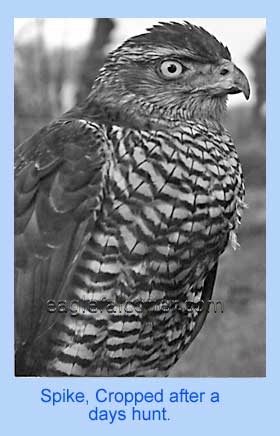 Spike was entered at moorhen, which he made look easy and it was, but I was not taking any chances with his first flight at quarry. The next day we were in St. Peters valley it is a picturesque valley with its steep sides heavily wooded with deciduous trees, mainly sycamore. A stream runs through the centre, 'This is collected into a small reservoir at the top of the valley, and from then on it meanders through numerous meadows and marshy swamps. Reeds and willows run rampant in these swamp areas and are ideal habitat for waterfowl. Spike was entered at moorhen, which he made look easy and it was, but I was not taking any chances with his first flight at quarry. The next day we were in St. Peters valley it is a picturesque valley with its steep sides heavily wooded with deciduous trees, mainly sycamore. A stream runs through the centre, 'This is collected into a small reservoir at the top of the valley, and from then on it meanders through numerous meadows and marshy swamps. Reeds and willows run rampant in these swamp areas and are ideal habitat for waterfowl.
Spike was riveted to my glove, he intently watched as two friends beat their way through the reeds. His head darted from side to side as they moved closer. Through my gloved hand, I could feel every sinew in his little body, tensed and ready. Suddenly the water exploded as a pair of mallard burst from the cover of the reeds. Spike left the fist in an instance, my part was a mere perch. As I stood there ankle deep in swamp mud and my mouth open, my eyes soaked in the action. This swampy area was surrounded on three sides by tall trees of oak and sycamore, the pair of mallard had to climb almost vertical to clear the trees. The drake was first with the duck close behind, droplets of water were still raining down when Spike hit the duck fair and square. They both fell, down into the water, now the duck had the advantage and dived, pulling Spike down to his neck. He opened his wings using the leverage on the surface of the water to lift himself up. The duck dived again, and now Spike was resisting going under by using his wings,
At last I cracked into action pulling at the suction of mud around my boots. I surged forward through the reeds and into the water and swept both Spike and his quarry onto dry land.
As I emptied the cold, muddy, stinking water from my boots, excited versions of what had just taken place were recounted as seen from different angles. With Spike rested, fed, and the duck in the hawking bag, I squelched my way home a very happy lad.
It was three or four years later before Spike ever flew or looked at another duck. He was not going to risk being submarined by one of those again. I used this to my advantage one season when I was asked to clear some moorhens and coots, or at least reduce their numbers a bit, from an ornamental duck lake, Spike was excellent at this, whilst he sat up in a tree, I could walk around the edge of the lake beating the reeds and brambles.
There were numerous breeds of duck, teal, tufted, mandarin, carolina, mallard and shellducks. They were flying, 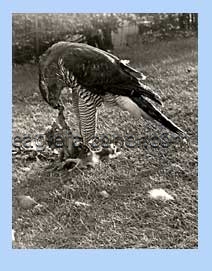 swimming and flapping about, not a blind bit of notice did Spike pay to them. Out of some cover flew a moorhen and within twenty yards he would have it. swimming and flapping about, not a blind bit of notice did Spike pay to them. Out of some cover flew a moorhen and within twenty yards he would have it.
He hunted well in his first season, taking a variety of quarry, moorhen, coot, rail, rabbit, rat and the occasional crow.
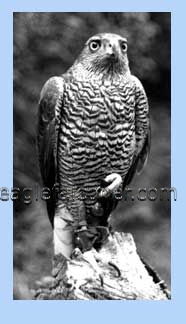 In our second season we thought to add some adventure in with our hunting, and so decided to spend a weeks hawking on Herm Island. Herm is one of the smaller Channel Islands and is off the coast of Guernsey. In winter it is very quiet, with just a few islanders and Major Wood and his wife, who own the tenancy of the island. In our second season we thought to add some adventure in with our hunting, and so decided to spend a weeks hawking on Herm Island. Herm is one of the smaller Channel Islands and is off the coast of Guernsey. In winter it is very quiet, with just a few islanders and Major Wood and his wife, who own the tenancy of the island.
The planning for the trip started with a letter to Major Wood asking permission to come to the island, also if we could camp out in the old monastery at the top of the island. Also would he give us a lift in his motor launch across the channel between Guernsey and Herm.
When I received the affirmative details from the Major, it left the small matter of chartering a small island hopping plane.
With all our equipment gathered together, a couple of friends and I with our hawks in boxes, stood in the departure room. Our luggage an our persons were weighed at check-in, and we were allocated our seating positions according to weight, in order to keep the plane in balance.
With everything stored in the tail section, we buckled up two a breast across the plane, the pilot's foot flat to the floor, we rattled down the runway. We seemed to go on forever bouncing along the runway, with the pilot joking about the hawks in the back doing a bit of flapping before we ran out of runway. The words were hardly out of his mouth when we literally had done just that. The plane shot out into the blue off the edge of the cliff and gilded out over the sea. Now the, fun started is we battled into a headwind, buffeted this way then that. All the time trying to answer questions from the pilot about the noble art of falconry, shouting above the engine and wind noise.
Fifteen minutes or so later we are nose-diving for Guernsey Airport, I am sure these guys still think they are flying fighter planes.
After unloading the plane and loading up two taxis we headed off across the. island for the little harbour of St. Peter's Port, where we hope the Major's boat will be waiting. His boat is the only vessel making daily trips throughout the year, so if we missed it we would have to wait until the next day or charter a fishing boat to make a special trip. I put it down to good planning rather than luck as we arrived early, in fact the Major's boat was just arriving into the harbour.
Once the boat had tied up, we all lent a hand to unload the milk churns, which, with the mail, is the main reason to run the boat every day. There are forty or more churns to unload, and by heck they were heavy and awkward, especially from a heaving boat. The effort was appreciated and we were given a hand to load all our gear down into the boat. Within half an hour we were heading out of the harbour mouth, and I for one was hoping for a calm crossing.
As we approached Herm it was decided that the tide was too low for the main pier, and so we headed southwards down the coast. We passed between Herm and her smaller sister island of Jethou, I have never landed on Jethou but from the boat it looks a beautiful place with just one house tucked snugly into the hillside. The boat turns, now heading for the low water landing steps of Rosiere. Unloading is not so easy here, but we all manage with fairly dry feet. We carry all the gear and the much travelled hawks in their boxes, up the pink granite steps, through a stone archway and onto a granite gravelled road. There is a tractor and trailer waiting to take the empty churns to the farm. This is the only mechanised form of transport on the island, and when we are offered a lift to the top of the island we are most grateful.
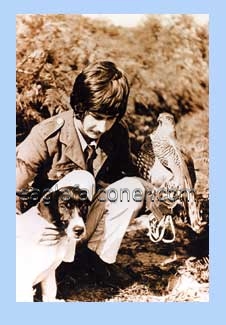 At last we had arrived, and we unloaded our gear from the trailer, it had taken us the best part of the day to travel no more than twenty miles. First things first, we take our bow perches out onto the lawn in a lovely sheltered, walled garden. Then quickly un-box the hawks and tether them out to settle down until evening. At last we had arrived, and we unloaded our gear from the trailer, it had taken us the best part of the day to travel no more than twenty miles. First things first, we take our bow perches out onto the lawn in a lovely sheltered, walled garden. Then quickly un-box the hawks and tether them out to settle down until evening.
We soon had our kit unpacked, sleeping bags laid out on the bare mattresses and our beds were made, The stove unpacked and the calor
gas connected and we soon had a brew going. We then s(et about rustling up a stew for our evening meal, and then made plans to walk down the hill to the harbour, to find someone to open up the Mermaid Tavern.
Herm Island is a goshawkers paradise, although a very small island, one and a half miles by half a mile , it is like all the Channel Islands in that its terrain is very diverse. The main bulk of the island rises very steeply from the sea, these southern cliffs are the home to many species of sea birds. There are numerous little valleys which open out into small sandy bays between the cliffs.
The tops of the cliffs are banked in reasonably steep headlands which are richly covered in bracken and brambles, and are good hunting grounds.
The top of the island is mainly grazing pasture for the island’s fine milking herd of Guernsey cows. These fields are surrounded with dry stone walls made with sea tumbled boulders. Each field has its own name, Big Sea Gull, Top Valley Panto, Moss Field and the Frying Pan. These and many more became familiar names to use as we recounted tales of flights each evening in the tavern. Then to the north, the island drops to almost sea level, and a large area of sand dunes and common land.
The main quarry on the island is the rabbit and our main reason for being here was the quantity. They say there is about a thousand rabbits to each Islander. There was also a healthy number of pheasants, this was exciting for us as Herm is the only member of the Channel Islands to have any pheasants. The Major would not allow any of the pheasants to be shot, but he turned a blind eye if one or two befell the dash of the goshawks.
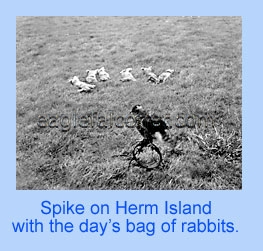 Little Spike was in his element and he could catch five or six rabbits in a day, but like all goshawks he considered anything that moved. Little Spike was in his element and he could catch five or six rabbits in a day, but like all goshawks he considered anything that moved.
One particular day we were hunting a small valley, both sides were heavily wooded, with a small grazing meadow in the bottom. Spike was perched in a tree with a good view, as John and I beat all likely patches of ground cover, There was a sound of bells and Spike was off, but not to where we had been beating. No, he was off to the other side of the valley and he was in one of those purposeful glides which meant he was locking onto something. We were off in the same direction, only we had to run down through the wood, negotiate a barbed wire fence, cross the meadow, another wire fence and up the steep opposite side.
It was as we were scrambling over the second fence that Spike crashed through the tree tops and made contact. Instantly there was the loudest yelling, spitting and hissing, I thought "CAT! Oh My God!" We sped up through the wood to find Spike in a double foot clench with a long eared owl, both birds were holding one another by the feet and glowered yellow eye to orange eye. We rescued Mr. Long Ears and took him back to camp for a check-up, after a short spell in confinement, was released in the same wood from whence he came.
A couple of days later we were hunting along the top of the cliffs on the south of the island, when Spike spotted a bunny's white flash hop over the edge. At an instance Spike was off my fist and in hot pursuit, I saw him make contact and then lost him from sight. When I got to the edge he was nowhere to be seen. Then I spotted him about twenty feet below, laid on his side. I scrambled down and picked him up, I thought he was dead, I just could not believe it and felt a sick feeling in my stomach, but then he moved, and slowly got to his feet. He had grabbed the rabbit, and the force of the impact had pushed the rabbit over the edge. Spike had not let go of the rabbit until he had made contact with Terra Firma again. This impact had concussed him, giving bunny a chance to escape.
I sat for ten or fifteen minutes with him on the fist whilst he recovered. We decided to call it a day and returned to camp. As I got to my feet, another rabbit bolted and Spike was off like a flash. He grabbed him in fine style as if to confirm that a bang on the head was not going to stop his fun.
Spike and I returned to Herm at least once every hunting season,and we spent many hours together, beating the islands bracken for rabbits.
Three or four hunting seasons and spike was taking duck in fine form. It was as if he felt, one day I'll sort these blighters out, and he took a mallard drake out of the air. He took many ducks that season, and we celebrated every time on roast duck for evening meal, toasting little Spike's continued health.
3139 words |
